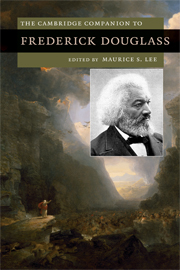Book contents
- Frontmatter
- Introduction
- 1 Douglass’s Self-Making and the Culture of Abolitionism
- 2 Identity in the Autobiographies
- 3 Douglass as Orator and Editor
- 4 Crisis and Faith in Douglass’s Work
- 5 Violence, Manhood, and War in Douglass
- 6 Human Law and Higher Law
- 7 Sentimental Douglass
- 8 Douglass among the Romantics
- 9 Douglass’s Black Atlantic: Britain, Europe, Egypt
- 10 Douglass’s Black Atlantic: The Caribbean
- 11 Douglass, Ideological Slavery, and Postbellum Racial Politics
- 12 Born into Slavery: Echoes and Legacies
- Guide to Further Reading
- Index
2 - Identity in the Autobiographies
Published online by Cambridge University Press: 28 July 2009
- Frontmatter
- Introduction
- 1 Douglass’s Self-Making and the Culture of Abolitionism
- 2 Identity in the Autobiographies
- 3 Douglass as Orator and Editor
- 4 Crisis and Faith in Douglass’s Work
- 5 Violence, Manhood, and War in Douglass
- 6 Human Law and Higher Law
- 7 Sentimental Douglass
- 8 Douglass among the Romantics
- 9 Douglass’s Black Atlantic: Britain, Europe, Egypt
- 10 Douglass’s Black Atlantic: The Caribbean
- 11 Douglass, Ideological Slavery, and Postbellum Racial Politics
- 12 Born into Slavery: Echoes and Legacies
- Guide to Further Reading
- Index
Summary
Douglass published three autobiographies during his lifetime - Narrative of the Life of Frederick Douglass, An American Slave (1845), My Bondage and My Freedom (1855), and Life and Times of Frederick Douglass (1881, 1892). The first of the autobiographies draws considerably on the conventions of the slave narrative; the second and third are more expansive autobiographies, though still somewhat indebted to the slave narrative tradition of describing in documentary fashion the journey from slavery to freedom. But Douglass is no mere documentary realist. Most notably in his accounts of his resistance to the slave-breaker Covey, he tells the same story differently in his autobiographies, depending on the larger truths he wishes to underscore at the time of composition. Douglass’s autobiographical narratives provide a rich resource for his biographers, as well as for historians of slavery, abolitionism, and the politics of race in nineteenth-century American culture. Perhaps most importantly, they provide insights into Douglass’s evolving sense of his representative identity and his artistry of self-presentation. In all of the autobiographies, Douglass skillfully crafts an image of himself as a heroic black man and a model for the race, whose energy, will, and intelligence helped him to rise from his obscure origins in slavery to become the representative black leader of his time. But there are also mysteries of identity in the autobiographies, a sense that he never quite knows or comes to terms with his racial or private identity. Thus Douglass is constantly in the process of reinventing himself. Identity is never stable in Douglass; it is tied to the contingencies of the historical moment and to the problematics (and challenges) of the autobiographer’s art.
- Type
- Chapter
- Information
- The Cambridge Companion to Frederick Douglass , pp. 31 - 45Publisher: Cambridge University PressPrint publication year: 2009
- 21
- Cited by



